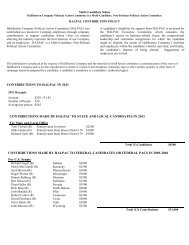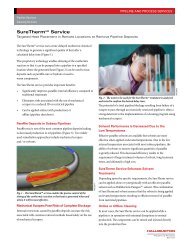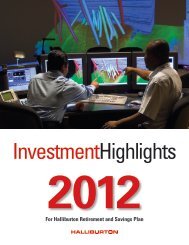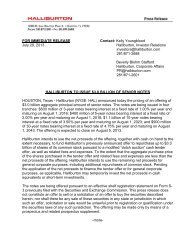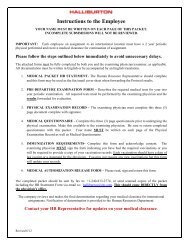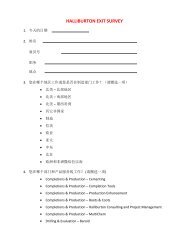HP/HT Client Brochure - Halliburton
HP/HT Client Brochure - Halliburton
HP/HT Client Brochure - Halliburton
You also want an ePaper? Increase the reach of your titles
YUMPU automatically turns print PDFs into web optimized ePapers that Google loves.
As conventional sources of oil and gas decline,<br />
operators are increasingly turning their attention<br />
to unexplored or underdeveloped areas. High<br />
temperatures and/or high pressures are often found<br />
in these uncharted territories, presenting complex<br />
challenges including casing buckling, accelerated<br />
drilling fluid chemical reactions and rock collapse.<br />
<strong>Halliburton</strong> is well equipped to handle your <strong>HP</strong>/<strong>HT</strong> challenges<br />
<strong>Halliburton</strong> has more than 1,500 global <strong>HP</strong>/<strong>HT</strong> experts and<br />
the largest selection of <strong>HP</strong>/<strong>HT</strong> capabilities in the industry. Our<br />
experts approach <strong>HP</strong>/<strong>HT</strong> challenges by initially establishing<br />
a detailed understanding of your reservoir. After developing<br />
the most effective plan, we help operators execute, using the<br />
latest <strong>HP</strong>/<strong>HT</strong> evaluation, well construction, completions and<br />
stimulation technologies.<br />
<strong>Halliburton</strong> continually creates innovative <strong>HP</strong>/<strong>HT</strong><br />
technologies and processes that increase efficiency, recovery,<br />
safety and reliability in our specialized <strong>HP</strong>/<strong>HT</strong> research and<br />
development (R&D), testing and manufacturing facilities.<br />
These world-class facilities are equipped with the greatest<br />
number of test wells and cells in the service industry.<br />
Challenge spurs innovation that creates better tools<br />
and technologies<br />
From high pressure oil reservoirs in the deepwater to deep,<br />
hot, high pressure gas reservoirs, operators entrust <strong>Halliburton</strong><br />
with their toughest challenges.<br />
About <strong>HP</strong>/<strong>HT</strong><br />
According to the SPE E&P glossary, high temperature is where<br />
the undisturbed bottom hole temperature (at prospective reservoir<br />
depth or total depth) is greater than 300°F or 150°C. As for high<br />
pressure, that definition is met when the maximum anticipated<br />
pore pressure of the porous formation to be drilled exceeds a<br />
hydrostatic gradient of 0.8 psi/ft, or the well requiring pressure<br />
control equipment has a rated working pressure in excess of<br />
10,000 psi or 69 MPa.<br />
<strong>Halliburton</strong> has further defined <strong>HP</strong>/<strong>HT</strong> wells as follows:<br />
Borehole Temperature<br />
<strong>HT</strong> >300°F (150°C) - 350°F (175°C)<br />
Extreme <strong>HT</strong> >350°F (175°C) - 400°F (200°C)<br />
Ultra <strong>HT</strong> >400°F (200°C) and above<br />
Borehole Pressure<br />
<strong>HP</strong> >10,000 psi (69 MPa) - 15,000 psi (103 MPa)<br />
Extreme <strong>HP</strong> >15,000 psi (103 MPa) - 20,000 psi (138 MPa)<br />
Ultra <strong>HP</strong> >20,000 psi (138 MPa) and above<br />
As tools and technologies for these wells become conventional, the<br />
temperatures and pressures considered high, extreme or ultra will<br />
continue to rise.<br />
1 High Pressure/High Temperature






